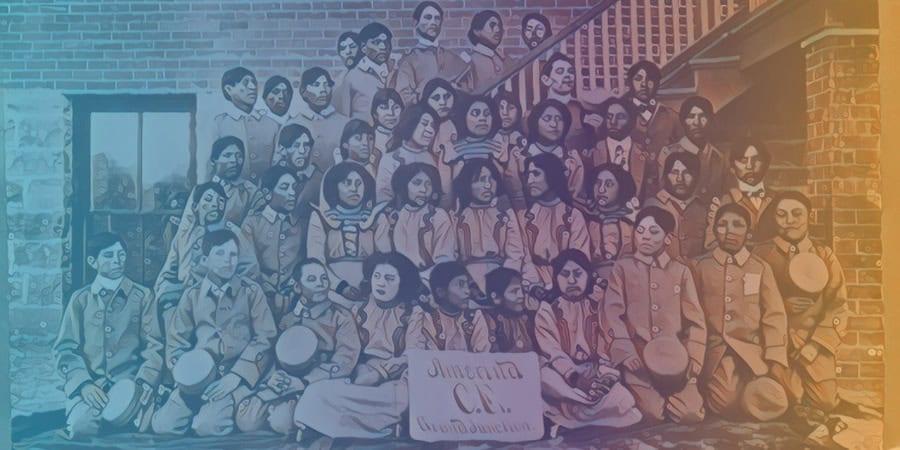Key Takeaways
- Native American children were forcibly removed from their homes and sent to more than 400 boarding schools as part of the federal program of forced assimilation that lasted from 1819 to 1969. They were subjected to severe physical abuse and cultural erasure.
- The Federal Indian Boarding School Initiative was launched in June 2021 to investigate the lasting impacts of these boarding schools. The investigation's first report identified 408 federal Indian boarding schools across 37 states and territories, as well as marked and unmarked burial sites at approximately 53 schools.
- The Native American Indian Boarding School Healing Coalition (NABS) is working to establish a Congressional Truth Commission to investigate the lasting impacts of these boarding schools. Deborah Parker, CEO of NABS, emphasizes the need for accountability and understanding of the lasting trauma caused by these schools.
- Survivors and their families hope for a future where the truth about these boarding schools is acknowledged, and the healing process can truly begin. The Tulalip community is working to reverse the harms of the Indian boarding school system, focusing on decolonizing the classroom and embracing traditional teachings.
- Unmarked graves have been found at the Tulalip Indian Reservation Cemetery near the old boarding school grounds. Tribal Chairwoman Teri Gobin and local historians believe some of these nameless graves could belong to children who died under unknown circumstances at the school.
At his home in Snohomish County, Washington, 77-year-old Matthew Warbonnet reflects on his childhood experiences at the Catholic-run, federally-funded St. Francis Mission on the Rosebud Reservation in South Dakota.
He shares stories of the neglect and violence he and his fellow Native American students experienced at the hands of the school’s staff.
Congressional Testimony
In May 2022, Warbonnet testified before Congress about the horrors he and other survivors faced at the more than 400 boarding schools that were part of the federal program of forced assimilation that lasted from 1819 to 1969.
Separated from his family at six years old, Warbonnet recalls the loneliness and fear that accompanied his time at the St. Francis Mission School.
The Brutal Reality of Boarding Schools
Physical labor, regimented chores, and forced attendance at Catholic mass were all part of the daily routine at these schools.
Students were also subjected to severe physical abuse, including beatings with a leather belt, a willow stick, or a braided rope.
Warbonnet describes how the whippings were so brutal that he and other children would be sent to the infirmary to recover for hours or even days.
The History of Forced Assimilation
The Indian Civilization Act Fund of 1819 and the Peace Policy of 1869 led to the creation of these boarding schools, with the goal of assimilating Native American children into white American society.
This policy, which was epitomized by the motto “Kill the Indian, save the man,” forcibly removed children from their homes and sent them to these institutions where they faced cultural erasure and abuse.
Truth and Healing Commission on Indian Boarding School Policies Act
Deborah Parker, CEO of the Native American Indian Boarding School Healing Coalition (NABS), is working to establish a Congressional Truth Commission to investigate the lasting impacts of these boarding schools.
The commission would hold subpoena power over churches, organizations, and the federal government to obtain records from the former boarding schools.
The Federal Indian Boarding School Initiative
In June 2021, Secretary of the Interior Deb Haaland launched the Federal Indian Boarding School Initiative, which includes an extensive investigation by the Department of the Interior and a “Road to Healing” tour to gather testimonies from survivors and their families.
The investigation’s first report, released in May 2022, identified 408 federal Indian boarding schools across 37 states and territories, as well as marked and unmarked burial sites at approximately 53 schools.
The Indian Civilization Act Fund of 1819 and the Peace Policy of 1869 led to the creation of these boarding schools, with the goal of assimilating Native American children into white American society.

The Fight for Accountability
Parker emphasizes the need for accountability and understanding of the lasting trauma caused by these schools.
She speaks of the intergenerational pain that many Native American families still experience today, as well as the ongoing effects of colonization and cultural erasure.
The Personal Connection
Parker’s own family history is deeply entwined with the Indian boarding school era. Her great-great-grandmother, Harriette Shelton-Dover, attended the Tulalip Indian Boarding School and faced abuse, malnutrition, and the loss of her language and culture.
In her 1991 autobiography, Tulalip, From My Heart, Shelton-Dover recounted the painful memories of her time at the school and the lasting impact it had on her life.
Tulalip Indian Reservation Reckons with Painful Legacy of Boarding Schools
A Deafening Silence Surrounds the Old School
As the “Road to Healing” tour continues, survivors and their families hope for a future where the truth about these boarding schools is acknowledged, and the healing process can truly begin.
The colonial-style building of the old school on the Tulalip Indian Reservation stands empty, with polished wooden floors and a modernized industrial kitchen.
The space occasionally hosts community events, but the echoes of crying children still linger, according to Rozanne Parker, a tribal member.
She describes the school, which operated from 1857 to 1932, as a concentration camp for Native American children.
The boarding school served as a hub for thousands of children from neighboring reservations, but few people speak about the events that took place there.
The Tulalip Indian Reservation is home to around 2,700 people and covers 22,600 acres along the coast. It is the traditional territory of the Duwamish, Snohomish, Snoqualmie, Skagit, Suiattle, Samish, and Stillaguamish peoples.
The tribe’s crest of an orca whale is prominently displayed on public buildings, and traditional artwork depicting ancient legends can be found throughout the community.
The Road to Healing and Remembering the Past
The last Indian boarding school in the United States closed in 1978 when Native American parents gained the legal right to refuse their children’s placement in such institutions under the Indian Child Welfare Act.
However, the traumatic experiences of survivors continue to affect the community across generations. Parker has collected hundreds of accounts from survivors, describing unimaginable acts of violence and abuse.
She also points out the recurring stories of incinerators used to dispose of babies born after young girls were raped by priests.
These disturbing stories reveal the depth of suffering endured by the children at these schools.
Unmarked graves have been found at the Tulalip Indian Reservation Cemetery in Mission Beach, near the old boarding school grounds.
Tribal Chairwoman Teri Gobin and local historians believe some of these nameless graves could belong to children who died under unknown circumstances at the school.
Parker also suspects there could be undiscovered burial mounds under the old school grounds.
The Search for Truth and Healing Continues
Gobin contends that the American public is not ready to admit what their ancestors did. Despite the progress made, there is still a lot of healing that needs to happen.
The Tulalip community is working to reverse the harms of the Indian boarding school system, focusing on decolonizing the classroom and embracing traditional teachings.
For survivors like Matthew Warbonnet, who has testified at the “Road to Healing” tour, speaking out is not for personal healing but to ensure the truth is known and the perpetrators are held accountable.
He believes that repatriation in the form of financial resources and the return of federal reserve land to Native communities is crucial for restoring culture and identity.
Parker, unwavering in her quest for justice, prays on the Tulalip grounds, singing a traditional Tulalip song in the language the boarding school attempted to eradicate.
She is determined to ensure the suffering of her people and the earth will not go unanswered.








